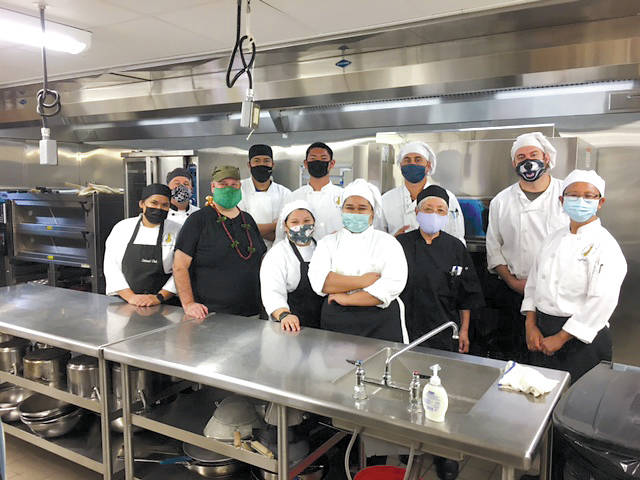
Chef Stephen Rouelle, third from left, was a guest lecturer at the Hawaii Community College — Palamanui Culinary Arts students earlier this semester. (Courtesy photo/Special to West Hawaii Today)
We’re lucky here at Hawaii Community College — Palamanui. We operate in a community with extremely talented chefs and have an organization — the Hawaii Culinary Education Foundation — that brings these chefs into the classroom to guest lecture for our students.
Why is this valuable? It’s important to introduce students to new culinary experts who can supplement their associate degree curriculum. As the Hawaiian proverb says, “A‘ohe pau ka ‘ike i ka halau ho‘okahi,” which means, “One learns from many sources.”
Earlier this semester, our guest lecturer was Chef Stephen Rouelle, founder and chef behind the vegan, vegetarian and raw food restaurant, Under the Bodhi Tree, which was founded in Kona in 2014.
Chef Stephen’s demonstration, titled “Understanding Veganism in Professional Food Service,” was fascinating. It culminated in a recipe demonstration for vegan corn chowder that was as good if not better than the traditional recipe that includes bacon.
But first, Chef Stephen began with the basics, which is important because not everyone understands what veganism is. He defined it as “a way of living which seeks to exclude, as far as possible and practicable, all forms of exploitation of, and cruelty to, animals for food, clothing or any other purpose.”
He also made sure to tell our students why this knowledge is important, pointing out that 3% to 4% of the world is vegan and in Hawaii’s tourism-based economy, restaurants serve customers from all over the world.
“When providing service to guests in a food and beverage setting you will be asked to understand many concepts around how people dine and eat,” Chef Stephen noted.
He added: “I would ask you to understand that ultimately we are in the people business, not the food business. Producing food is a far easier task than producing food to meet people’s expectations of taste, quality and value within their needs and desires.”
That’s a really important point, and culinary student Kamaile Gusman said that was her big takeaway from the presentation.
“You don’t have to be vegan,” she said, “but it is important to learn about different dietary needs to be able to cater to different people.”
So, how to meet a customers’ expectations for taste and quality while cooking vegan? It was interesting to see Chef Stephens’ approach, in which he identifies the flavor profiles of ingredients like bacon and then tries to capture those using ingredients such as Bragg’s liquid aminos, liquid smoke and others.
The proof was in the chowder. It was really delicious and opened up the students’ eyes to what vegan cuisine actually can be. But you don’t have to take my word for it. You can make some yourself. Or if you’d rather have the pro cook for you, Chef Stephen has some new things happening in addition to the Under The Bodhi Tree serving at Kaimu Farmers Market on Saturdays in Pahoa. Chef Stephen is also doing a weekly meal delivery in Kona, Keauhou, Pahoa and Hilo. He recently opened Kohala Coffee Co. at Puna Kai in Pahoa and expects to have Under The Bodhi Tree Pahoa and Banzos Falafel open this summer in Pahoa. Later in the year, he’ll have a second Kohala Coffee Co. and Bodhi Tree Juicery and Deli in Waikoloa Village.
Mahalo to Chef Stephen and the Hawaii Culinary Education Foundation for enhancing our program of culinary studies!
Vegan Corn Chowder
1 medium onion, diced
2 stalks celery, diced
3 sprigs fresh thyme
1 bay leaf
1 cup corn kernels
2 teaspoons brown sugar
Dash smoked paprika
3 drops liquid Smoke
1/4 teaspoon black pepper
3 Tablespoons Braggs Liquid Aminos
3 Tablespoons flour
3 cups vegetable stock (see recipe below)
2 cups oat milk
1 russet potato (skin on) diced
1 1/2 Tablespoons chopped parsley
Add 3 Tablespoons Coconut oil to a medium-size, 3-quart soup pot. Add and saute the onion and cook over a medium heat for about 10 minutes to build flavor. Add and sweat the celery for a few minutes on a medium heat. Add the thyme and bay leaf and sweat for about 30 seconds. Add the corn and sautee another 30 seconds. Add the sugar, paprika, liquid smoke, black pepper and aminos and reduce to a syrupy consistency. Dust the mix with flour and cook out the flour (about 2 minutes).
Add the vegetable stock (recipe below) and bring to a boil and reduce to a simmer. Add oat milk and taste and adjust seasoning. Add salt and pepper to taste. Cook until potatoes and vegetables are tender and soup is reduced to create richness and flavor. Finish with chopped parsley.
Basic neutral vegetable stock
1 onion, rough dice
1 medium carrot, rough dice
2 celery stalks, rough dice
1/2 teaspoon Fennel seed
10 peppercorns.
Dash of turmeric
1 tomato, rough dice
2 Tablespoon soy sauce
1-inch by 2-inch strip kombu (edible kelp)
32 oz. cold water
Place all ingredients into a pot and allow it to sit overnight in refrigeration. Place on a slow stove top and bring to a simmer. Cook for 1 hour. Strain and cool.
This vegetable stock can be made ahead and reserved for use.
Every semester, students of Leeward Community College’s Culinary Arts program participate in an event which brings a successful (sometimes world-renowned) chef to the campus for a unique learning experience. The “Culinary Assembly” held in partnership with the Hawaiʻi Culinary Education Foundation consists of a live cooking demonstration by a chef, followed by a question and answer portion and closes with the awarding of scholarships.
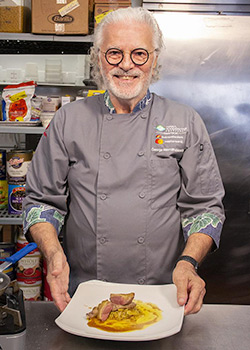
Chef George “Mavro” Mavrothalassitis
In February, James Beard award-winning chef George “Mavro” Mavrothalassitis thrilled students with his culinary techniques. Chef Mavro prepared Squab en Papillote with Savoy Cabbage and Foie Gras for students on Zoom.
“Basically, it’s a way to expose students to different elements of the culinary world that they might not get in a classroom—it has become an extension of our education beyond the curriculum,” said Associate Professor Matthew Egami.
The long list of participating chefs includes Chris Kajioka, Chai Chaowasaree and D.K. Kodama, who have all given their time to speak to students about their experiences and how they were able to overcome challenges in their specific areas of the culinary industry.
Students love this interaction as they get to see these chefs up close and, before the coronavirus pandemic, they were able to taste the dishes being prepared.
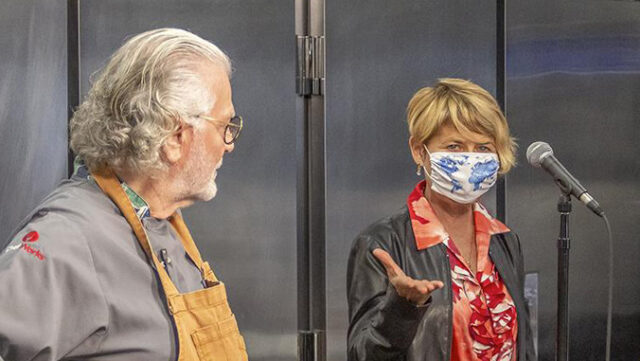
Chef Mavro with Hayley Matson-Mathes of the Hawaiʻi Culinary Education Foundation

Squab en Papillote
“The Hawaiʻi Culinary Education Foundation is dedicated to the development and support of culinary training programs throughout the state of Hawaiʻi,” said Executive Director Hayley Matson-Mathes. “The foundation’s mission is to raise the culinary bar in Hawaiʻi.”
Having to shift the Culinary Assembly to a completely virtual event during the last two semesters did have some advantages. Shyer students were more inclined to ask questions without the fear of being in a crowd, with all eyes on them.
Students were also eager for the final portion of the event where scholarships were given out. Thanks to very generous donations, these scholarships usually total about $10,000 or more. Consistent donors include: Armstrong Produce, Evelyn Shun Newman, Hawaii Gas, Hawaii Lodging and Tourism Association, Nobuye Horio, Russel J. Hata, Stephen and Eugenie Werbel and Sunao Sandy Kodama. The program also generates scholarship money through events such as a Scholarship Brunch.
Thanks to the Hawaiʻi Culinary Education Foundation, the numerous donors and the industry partnerships built by Leeward CC’s faculty, students will continue to reap the benefits of the Culinary Assembly and the wisdom of renowned chefs for years to come.
—By Tad Saiki
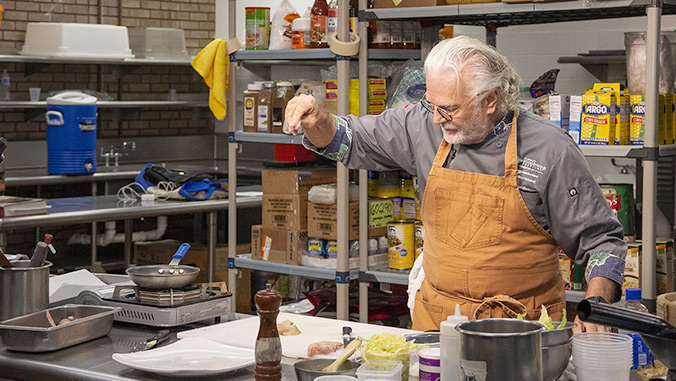
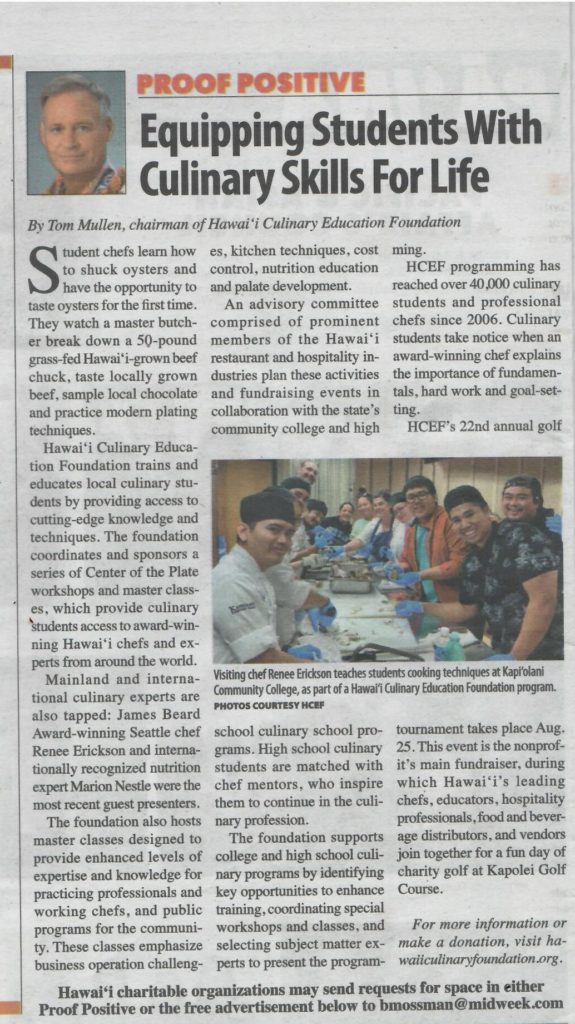
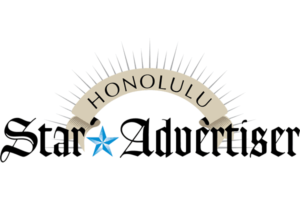
Food industry complicates the act of eating well, a nutritionist Marion Nestle says
By Nadine Kam
Oct. 29, 2019

MARION NESTLE, COURTESY MARTIN ADOLFSSON
Weight loss is big business in this country. It’s an industry that grew by about 4% last year, from $69.8 billion to $72.7 billion, according to MarketResearch.com, and is expected to grow 2.6% annually through 2023, fueled by meal-replacement products, obesity drugs, bariatric surgeries and weight-loss programs.
It’s arguably money spent unnecessarily if heeding the simple advice touted by nutrition expert Marion Nestle (rhymes with trestle) as she crosses the country talking about the challenges consumers face when food meets politics. “It’s hard for people to make sensible food choices in an environment where marketing plays a heavy role,” she said in an interview from her New York office. “Processed foods are heavily advertised, so people don’t realize how easy it is to eat healthfully. (Journalist/author) Michael Pollan summed it up in seven words: ‘Eat food, not too much, mostly plants.’”
It seems like common sense, but according to Nestle, many people have lost the ability to recognize healthful food after a couple of generations weaned on heavily processed and packaged products.
Since the 1980s, Nestle has taken on government, the food industry and the food marketing industry to bring to light their roles in the obesity epidemic and other health hazards. Nestle will give a free talk on “What to Eat: Dietary Advice Meets Food Politics” next week at the University of Hawaii’s Kennedy Theatre.
Nestle, the Paulette Goddard Professor of Nutrition, Food Studies and Public Health, Emerita at New York University and visiting professor of Nutritional Sciences at Cornell University, is the author of six award-winning books, including “Soda Politics: Taking On Big Soda (And Winning)” and “Unsavory Truth: How Food Companies Skew the Science of What We Eat.”
From 1986 to 1988, she was senior nutrition policy advisor in the U.S. Department of Health and Human Services and editor of the Surgeon General’s Report on Nutrition and Health.
In this day of hype and hyperbole, Nestle is respected for her reasoned approach to food politics. Talking to her is a breath of fresh air because she isn’t prone to hype or theatrics. When I suggest that many believe sugar is a drug, she calmly explains, “Sugar’s a food. It’s a nutrient. Plenty of people believe they’re addicted to something, but if that’s what they think, they need to be treated as an addict and get help from a 12-step program, or figure out some way not to eat it.
“If you can’t keep cookies in the house without eating the whole bag, then don’t keep it in your house.”
Nestle started her career as a nutritionist who found her current path as a crusader after attending a conference on the relationship between smoking and cancer. “It struck me that nutritionists should be doing the same thing with food.”
For a long time, she said, she couldn’t understand the confusion over how to select nutritious foods. In the introduction to her book, “What to Eat,” she wrote, “Doesn’t everyone know what a healthy diet is?”
But in talking to people across the country, she came across such comments as: “A lot of us are clueless and have no idea of how to eat,” “When I go into a supermarket I feel like a deer caught in headlights” and “I do not feel confident that I know what to eat. It’s all so confusing.”
She saw a discrepancy between nutrition knowledge and dietary behavior, largely shaped by food industry marketing and the human desire to believe a lie rather than an inconvenient truth, no matter how unrealistic.
For instance, children grow up with the knowledge than an apple is a more healthful choice than a cookie. But add the word “diet” in front of cookie and logic flies out the window as people rationalize that a diet food cannot make you fat. A person who prefers cookies to apples will find any way to believe a cookie is a viable diet choice.
Foods labeled “low-fat,” “low-calorie” or “fat-free” are targeted toward those desperate to shed weight, who are most vulnerable to the allure of an easy fix, Nestle said. If a dieter has a craving and is presented with low-calorie cookies or zero-calorie cola, he or she might gladly believe it’s fine to consume both freely — unaware that artificial sweeteners in such products contribute to obesity.
A 2016 study published in the journal JAMA Pediatrics found that mothers who frequently consumed diet beverages were two times more likely to have babies who were overweight or obese at one year after birth, compared with women who consumed fewer artificially sweetened drinks.
A 2015 study published in the Journal of the American Geriatrics Society found that people who drank diet soda gained almost triple the abdominal fat over nine years as those who drank regular soda.
“It’s a very human response to want to believe,” Nestle said. “We don’t respond intellectually to such claims, but emotionally, and marketers know that. It’s very difficult to take on a $30 billion advertising industry.”
And in light of larger social issues such as immigration and gun policy, poverty and homelessness, the every day dietary habits of American citizens aren’t much of a concern to policymakers who believe adults are capable of making their own decisions.
One would think the message would be getting across, but obesity rates in this country continue to climb. According to data from the Centers for Disease Control and Prevention’s National Center for Health Statistics, 93.3 million of U.S. adults, nearly 40% of the population, suffers from obesity based on body mass index. (Colorado and Hawaii have the lowest obesity rates, at 23% and 24.9% of the population, respectively.)
Instead of wearying of the battle, Nestle is energized by noting much has changed for the positive.
“Food has gotten a lot better in 20 years. There are more farmers markets, more opportunities to buy fresh fruits and vegetables.”
Yet, while eating was once a matter of sustenance, the rise of food media has glamorized eating a lot as a way of life, from culinary travel programs to live mukbang videos that emphasize consumption in huge amounts. So Nestle’s latest cause has been portion control.
“Portion size has gotten so much bigger over time, so it’s very human for people to want to see a lot of food in front of them,” she said. “Everyone has to have a certain amount of calories to be healthy, but many eat more than they need and that puts them at risk for Type 2 diabetes and other ailments.”
It’s up to individuals to gauge how many calories they need by using height and weight as a barometer, understand that a single fast-food meal may contain all the calories they need for one day, and adjust one’s intake accordingly.
The formula of equal calories in and out should keep one’s weight in check. “I eat junk food, too, but I don’t eat a lot of it,” Nestle said. “It’s OK to have ice cream once in a while, and not very much.”